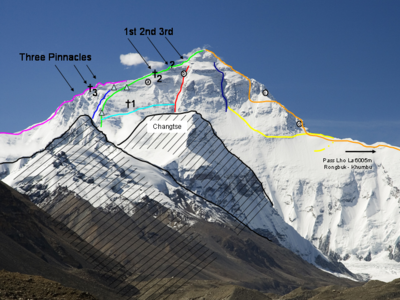Three rock steps (Mount Everest)
The three rock steps (English. "Three Steps" ) are three striking rock steps on the northeast ridge of Mount Everest . They are located at heights of 8564 m , 8610 m and 8710 m . The second step in particular is significant both from a historical and mountaineering point of view. Every mountaineer who wants to climb the summit on the normal route from the north has to overcome these three steps.
The first step consists of rough blocks, which can only be a serious obstacle for experienced mountaineers due to the height above sea level.
The second step is the best known of the rock steps. The steep step with a foot height of 8610 m has a climbing height of about forty meters, the last five of which are almost vertical. This area was defused in terms of climbing technology in 1975 when a Chinese team installed a ladder that has since been used by almost all mountaineers.
The following third step (“third step”) is easier to climb again. The climbing height is about 10 meters. Then the summit snow field is reached.
Important ascents of the second step
The British Mount Everest Expeditions were the first to attempt to climb Mount Everest before World War II . They had to climb from the north. The climbing difficulties, especially the second step, were still unknown at the time. To this day it is controversial whether George Mallory and Andrew Irvine , who died in an attempt to climb in 1924 , were able to overcome the Second Step with the means of their time and possibly have climbed it. In 1960 a Chinese expedition succeeded in a (initially not undisputed) first ascent of the entire northern Tibetan route, during which the Second Step was climbed through Wang Fuzhou , Konbu and Qu Yinhua . A shoulder stand was used to climb the last five meters.
The step was first "freely" climbed in 1985 by the Spaniard Oscar Cadiach , using the permanently installed ladder for safety. He rated the final difficulty of the steep face as 5.7 to 5.8 (V + according to UIAA classification).
The Austrian Theo Fritsche climbed the step Free Solo On Sight in 2001 and came to a similar assessment. Conrad Anker climbed the Second Step in 1999 and rated the level as 5.10. During this ascent, Anker supported himself on the Chinese ladder. In 2007, Anker repeated the ascent together with Leo Houlding, but this time he had the ladder removed beforehand so that he could climb the step freely .
literature
- Roberto Mantovani and Kurt Diemberger: Mount Everest - battle in icy heights . Moewig, 1997, ISBN 3-8118-1715-9 .
- Jochen Hemmleb: Mount Everest crime scene: The Mallory case - New facts and backgrounds . Herbig, Munich 2009, ISBN 978-3-7243-1022-8 .
Web links
Individual evidence
- ↑ Peter Gillmann: Everest . Bruckmann, Munich 2004, ISBN 3-86517-012-9 , pp. 44 ff .
- ↑ Peter Gillmann: Everest . Bruckmann, Munich 2004, ISBN 3-86517-012-9 , pp. 74-77 .
- ↑ explorersweb.com: Free-climbing Everests Second Step update: Before Fritsche was Oscar Cadiach the other Mallory. June 7, 2007, accessed November 22, 2015 .
